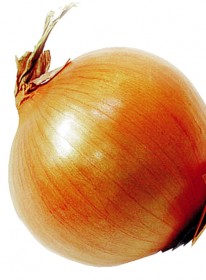You have to be very careful about applying too much nitrogenous fertilizer to onions, otherwise the bulbs will become too soft and susceptible to diseases like neck rot and downy mildew, especially if there is a wet period when they are growing and when good drainage become critical. Otherwise onions really don’t give too much trouble, and the most superb onions can be grown in Guyana. Once the onions have reached the right size the tops should be bent over. This exposes them to the sun and helps to ripen them beautifully. Some growers dig them up when they are fully grown, shake the soil off, and leave them on the surface to ripen.
I have in the past been a very keen owner of the dwarf Chinese bamboo, and have recently ‘discovered’ the variegated form of it in Europe which has the name Pleioblastus chino ‘Tsuboi.’ Heaven knows what its name is in the USA, but it’s likely to be simpler. Neither the green form or the variegated form are invasive, and make the most wonderful compact clumps in the garden. Definitely worth a go, as is the Pampas grass which is a South American native. Pampas grass normally produces the most attractive white plumes, but there is a pink form which has its place in the garden. Both are long flowering, and plumes can be cut and used in the house for
months on end.
 Very fine coconut fibre is just great for sowing seeds. Always slightly overfill the seed tray or pot using your fingers to firm the compost, and then water it, always a good idea before sowing any seeds. This avoids the danger of washing the seeds out of the tray or pot, or at least in a heap in the corners, especially if they are very small seeds like petunias or begonias which are sown on the surface anyway. With any seeds you have to be absolutely sure that they are not buried too deeply or they will not germinate at all, or at least only spasmodically. Large seeds like tomato or lettuce must be covered with a little soil to help them germinate in the dark.
Very fine coconut fibre is just great for sowing seeds. Always slightly overfill the seed tray or pot using your fingers to firm the compost, and then water it, always a good idea before sowing any seeds. This avoids the danger of washing the seeds out of the tray or pot, or at least in a heap in the corners, especially if they are very small seeds like petunias or begonias which are sown on the surface anyway. With any seeds you have to be absolutely sure that they are not buried too deeply or they will not germinate at all, or at least only spasmodically. Large seeds like tomato or lettuce must be covered with a little soil to help them germinate in the dark.
 Generally it’s a good idea to cover the seed with cling film drawn very tightly over the container, but a piece of dark plastic sheeting will do just as well. You’ll have to examine the box regularly so that germinating seedlings are exposed to the light as soon as they emerge from the compost – whatever type of compost you use.
Generally it’s a good idea to cover the seed with cling film drawn very tightly over the container, but a piece of dark plastic sheeting will do just as well. You’ll have to examine the box regularly so that germinating seedlings are exposed to the light as soon as they emerge from the compost – whatever type of compost you use.
Of course, young seedlings ought not to be exposed to the direct sunlight or they’ll just shrivel up and die, but they must have good light or they will become long and lanky and have a tendency to fall flat on their collective faces. Always bear in mind when you are sowing that you have to sow sparingly, unless you are to supply the entire village.
Always a good idea to place the seed in your cupped hand. And then tap your hand gently so that seed falls onto the compost in very small quantities. Always sow seed when there is no wind or when you are working in a sheltered place.

The same really applies when you are working outside, say sowing carrots, onions, beetroot, lettuce or tomato. With the seeds I’ve just mentioned make a drill about an inch deep with a piece of plank, sow the seed thinly, and cover. Sand can be used to cover the seed, and to mark the rows. It’s always good practice of course to label each row to tell yourself what’s there.
Soon it will be Christmas and I guess you will no doubt be frantic with all the preparations for this joyous festive season, but do take care and may your God go with you wherever you may be.









